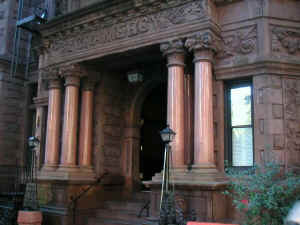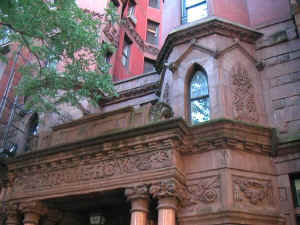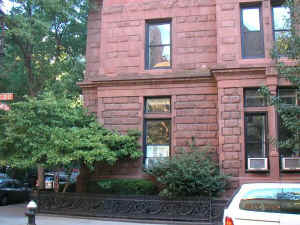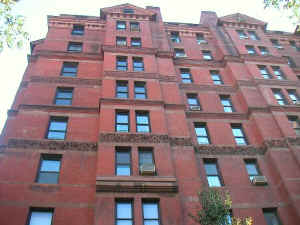 |
New York Architecture Images-Gramercy Park 34 Gramercy Park East |
|
architect |
George DaCunha, builder and developer |
|
location |
34 Gramercy Park East |
|
date |
1881 |
|
style |
Renaissance Revival |
|
construction |
red brick with brownstone trim |
|
type |
Apartment Building |
|
|
  |
  |
|
|
|
|
|
This early luxury apartment building, which
predates the Dakota, is one of the oldest in the city. Its generous
apartments were advertised as "French Flats" in order to distinguish
them from squalid working class tenements. In order to further enhance
its marketability to upper class tenants, this Victorian red brick
building was endowed with some of the features of a Fifth Avenue
brownstone. Its lobby was clad in opulent materials, and its large
apartments were limited to three per floor. The structure still contains
its original cable-driven Otis elevator.
Directly across the park, No. 34 Gramercy Park East is a brown multistoried structure built in 1883 by a group of investors; it was the first co-op apartment house in Manhattan. A plaque on the building states that actor James Cagney lived there from 1965 to 1968. Next door, at No. 36, a pair of helmeted, silver metal knights stand guard in front of an ornate building that was once home to the colorful John Ringling of circus fame. The park is private, with keys available only to residents; members of the Players and National Arts clubs; guests of the Gramercy Park Hotel, although sometimes others borrow a key from well-appointed friends. Stella and I are members of the National Arts Club, but I didn't feel like bothering to get the key, so I tried to take photographs through the iron fence that surrounds the little square. But it nearly was impossible with the wind and snow tugging at my umbrella. Just inside the fence, a bed of yellow tulips peeked from beneath their white blanket. |
|
|
STREETSCAPES/36 Gramercy Park East; Deep in
the Heart of Texas, A Glimpse of Old New York By CHRISTOPHER GRAY Published: October 24, 2004, Sunday GENEALOGISTS know that relatively few records exist about average people. Architectural historians know that while there is extensive documentation on important structures, like the Woolworth or Chrysler Buildings, it's much harder to find detailed information on the average buildings that make up much of our streetscape. But not many people are aware that a trove of drawings, specifications, photographs and other data exist on one lesser-known structure -- the 1909 apartment building at 36 Gramercy Park East. The information sheds light on the real world of turn-of-the-20th-century construction in New York City, but it's hardly a surprise that the material is little known -- it is part of an archive of more than 8,000 drawings and photographs from the architectural office of James Riely Gordon, and it's in Texas. In 1908, John E. Olsen, a contractor, had Gordon begin work on a 12-story building at 36 Gramercy Park East, overlooking the private, gated park. The building was planned as a co-op, with apartments of 8 to 10 rooms. In 1909, The Real Estate Record and Guide reported that the new building's interiors were varied in style, ''Old English, Colonial, French and Italian Renaissance, Louis XIV, XV and XVI.'' But the exterior is a startling expression of the Gothic, a huge, white, lacy terra cotta screen of pointed arches, gargoyles, bosses, shields and other elements of a style that was gaining popularity because it was suited to the vertical character of the new, taller buildings -- the Woolworth Building was completed in 1913 in a very similar style. Apartments at the Gramercy Park building were advertised for sale at $8,900 to $12,000, and some were rented at $2,350 to $3,168 a year. The 1915 census picked up a miscellany of businessmen and professionals, along with some artistic types -- like John Barrymore, who was a year away from breaking out of a career as a popular star of lightweight comedies and becoming one of the most acclaimed dramatic actors of his day. Within a few years, he would reinvent himself as the brooding lead in ''Richard III'' and ''Hamlet.'' Another resident was listed as a ''showman'' -- Alfred Ringling, one of five brothers who had established their famous circus in 1884. Although Olsen ran into financial problems just after completing the building, it appears that the structure remained a co-op until the 1940's, when it was converted to rentals. Gordon had worked in Texas in the 1880's and 1890's, and moved to New York around 1900. He died in 1937, and his papers ultimately went to the Alexander Architectural Archive at the University of Texas in Austin (www.lib.utexas.edu/apl/aaa). For 36 Gramercy Park East, they offer a level of documentation far beyond that which a researcher finds in local archives for the typical New York structure. There are dozens of small photographs of sculptured models of finials, capitals, colonettes and other details, before they were made into terra cotta molds. The 22-part set of specifications includes instructions to fabricators: ''Before commencing, have full-size plaster models made from the architect's designs,'' which were to remain at the building ''for comparison with the finished work.'' For the firing of the terra cotta, the specifications instruct, ''Burn hard and make to the exact profile and ornamental detail and of the exact colors to be approved by the architect.'' Installers were instructed to use ''colored mortar to exactly match shade of terra cotta.'' There are dozens of drawings, down to small items that might otherwise have been picked out of a catalog, or even left to a contractor's choice: ''detail of wrought iron elevator doors,'' ''details of ceilings in dining rooms'' and even ''large-scale details of bathroom windows.'' Contractors were required to ''furnish to the architect for his approval, three complete sets of drawings of every course of stonework, showing size, shape and jointing of every piece of stone including location of anchors, clamps and dowels.'' To judge from other passages, it appears this also included the terra cotta. There are about 100 courses of masonry on the facade. The initial specifications note that ''the architect reserves the privilege of examining the quarries'' from which any stonework was to be supplied, but this comment was deleted from the final version, without explanation. Addressing an issue familiar to anyone running a construction project, the specifications required the general contractor to ''provide conveniences for the use of the workmen employed on the building; supply same with properly located and well ventilated enclosures; remove their contents'' and at the end, ''thoroughly disinfect the site and supply fresh earth where necessary.'' The human element is displayed in the passage covering completed woodwork: ''scrape and sandpaper away all spots, finger marks, lime, acid, tobacco, oil and other stains.'' Not everything went as planned: the first three floors of the facade were meant to be marble but were executed in less-expensive terra cotta, and the entrance hall floor was specified as Tennessee marble, while in fact it was finished in a lovely, irregular art tile in brown, green, red and tan. A year ago, new owners took over the building and have begun a long renovation. The wildly veined marble walls in the lobby have been polished to dazzling brightness, and work is under way to replace the mid-20th-century elevators, which themselves replaced the original open-cage cabs. Maurice Mann, one of the partners who now own the building, has begun projects in several apartments that now look as they must have in 1909, with plaster dust, new piping and bare walls. He is also starting to rejoin many apartments long ago divided into multiple units, and one on the north side of the eighth floor is almost finished. It has a beamed ceiling in the foyer, leaded-glass transoms and four startling exposures, with views that include Gramercy Park, the Chrysler Building and the East River. Olsen and Gordon did not finish this apartment in a single mode: the mantel in the drawing room is in the style of Robert Adam, while that in the foyer is Italian Renaissance. Mr. Mann calls 36 Gramercy Park East ''one of the prettiest buildings in my portfolio'' and says that although his group is hoping to restore much of the building to its original condition, he is not interested in reconverting it to a co-op. Look For The neo-Gothic terra cotta detail over the main doorway (above) and the triplet windows on the ground floor. BUILT -- 1909 ADDRESS -- 36 Gramercy Park East HOW TO GET THERE -- No. 6 train to 23rd Street and Park Avenue South Published: 10 - 24 - 2004 , Late Edition - Final , Section 11 , Column 4 , Page 10 Copyright New York Times. |
|
|
links |
|